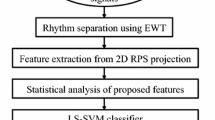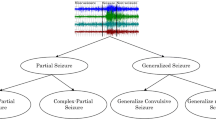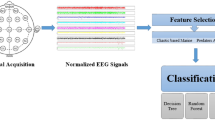Abstract
In this paper, the secure communication of the electroencephalogram (EEG) signal is presented via the wireless protocol. To obtain the goal of secure communication, a new stability condition for providing a new disturbance observer (DO) to estimate the attacked signals of the secure communication system is proposed. Herein, the fractional-order calculus was used to obtain the goal of the stability design. To meet the goal of the construction of the master and slave, the fractional-order chaotic system was used. First, the Takagi-Sugeno fuzzy was used to remodel the master and slave systems with support of the Grunwald–Letnikov approximation technique from continuous time to discrete time domain. Second, the DO was equipped to the slave system to reject the unwanted on both public channels and uncertain values on the master and slave sides. Third, the sliding mode control was designed based on the given stability theorem. Fourth, the stability was provided based on Lyapunov condition. Final, the simulation by using MATLAB software and experiment by using the ESP8266 chips with the wireless communication were provided to show the effectiveness of the proposed theories.














Similar content being viewed by others
References
Yan, N., Cheng, H., Liu, X., Chen, F., Wang, M.: Lightweight privacy-preserving feature extraction for EEG signals under edge computing. IEEE Internet Things J. 11(3), 2520–2533 (2023)
Liu, Y., Huang, H., Xiao, F., Malekian, R., Wang, W.: Classification and recognition of encrypted EEG data based on neural network. J. Inf. Secur. Appl. 54(102567), 1–10 (2020)
Singandhupe, A., La, H.M., Feil-Seifer, D.: Reliable security algorithm for drones using individual characteristics from an EEG Signal. IEEE Access 6, 22976–22986 (2018)
Anwar, S.M., Saeed, S.M.U., Majid, M., Usman, S., Mehmood, C.A., Liu, W.: A game player expertise level classification system using electroencephalography (EEG). Appl. Sci. 8(1), 18 (2018)
Stevner, A.B.A., Vidaurre, D., Cabral, J., et al.: Discovery of key whole-brain transitions and dynamics during human wakefulness and non-REM sleep. Nat. Commun. 10(1035), 1–14 (2019)
Meng, W., Cai, Y., Yang, L.T., Chiu, W.-Y.: Hybrid emotion-aware monitoring system based on brainwaves for internet of medical things. IEEE Internet Things J. 8(21), 16014–16022 (2021)
Rajesh, S., Paul, V., Menon, V.G., Jacob, S., Vinod, P.: Secure brainto-brain communication with edge computing for assisting post-stroke paralyzed patients. IEEE Internet Things J. 7(4), 2531–2538 (2020)
Shahzadi, R., Anwar, S.M., Qamar, F., Ali, M., Rodrigues, J.J., Alnowami, M.: Secure EEG signal transmission for remote health monitoring using optical chaos. IEEE Access 7, 57769–57778 (2019)
Wen, D., Jiao, W., Li, X., Wan, et al.: The EEG signals encryption algorithm with K-sine-transform-based coupling chaotic system. Inf. Sci. 622, 962–984 (2023)
Petrás, I.: Fractional-Order Nonlinear Systems: Modeling, Analysis and Simulation. Springer, Berlin (2011)
Lendek, Z., Guerra, T.M., Babuska, R., Schutter, B.: Stability Analysis and Nonlinear Observer Design Using Takagi-Sugeno Fuzzy Models. Springer, Berlin (2011)
Zhang, Z., Song, X., Sun, X., Stojanovic, V.: Hybrid driven based fuzzy secure filtering for nonlinear parabolic partial differential equation systems with cyber attacks. Int. J. Adapt. Control Signal Proces. 37(2), 380–398 (2023)
Song, X., Song, Y., Stojanovic, V., Song, S.: Improved dynamic event-triggered security control for T-S fuzzy LPV-PDE systems via pointwise measurements and Point control. Int. J. Fuzzy Syst. 25(8), 3177–92 (2023)
Zhang, Q., Song, X., Song, S., Stojanovic, V.: Finite-time sliding mode control for singularly perturbed PDE systems. J. Franklin Inst. 360(2), 841–861 (2023)
Chen, W.H., Ballance, D.J., Gawthrop, P.J., O’Reilly, J.: A nonlinear disturbance observer for robotic manipulators. IEEE Trans. Ind. Electron. 47(4), 932–938 (2000)
Wu, X., Xu, K., Lei, M., He, X.: Disturbance-compensation-based continuous sliding mode control for overhead cranes with disturbances. IEEE Trans. Autom. Sci. Eng. 17(4), 2182–2189 (2020)
Kuppusamy, S., Joo, Y.H.: Memory-based integral sliding-mode control for T-S fuzzy systems with PMSM via disturbance observer. IEEE Trans. Cybernetics 51(5), 2457–2465 (2019)
Giap, V.N.: Text message secure communication based on fractional-order chaotic systems with Takagi-Sugeno fuzzy disturbance observer and sliding mode control. J. Dyn. Control 11(6), 3109–23 (2023)
Nguyen, Q.D., Pham, Q.D., Thanh, N.T., Giap, V.N.: An optimal homogenous stability-based disturbance observer and sliding mode control for secure communication system. IEEE Access 11, 27317–27329 (2023)
Chen, M., Shao, S.Y., Jiang, B.: Adaptive neural control of uncertain nonlinear systems using disturbance observer. IEEE Trans. Cybernetics 47(10), 3110–3123 (2017)
Nguyen, Q.D., Huang, S.C., Giap, V.N.: Lyapunov-based fractional order of disturbance observer and sliding mode control for a secure communication of chaos-based system. Int. J. Control Autom. Syst. 21(11), 3595–3606 (2023)
Cicek, S., Kocamaz, U.E., Uyaroglu, Y.: Secure communication with a chaotic system owning logic element. AEU-Int. J. Electron. Commun. 88, 52–62 (2018)
Chen, Y.J., Chou, H.G., Wang, W.J., Tsai, S.H., Tanaka, K., Wang, H.O., Wang, K.C.: A polynomial-fuzzy-model-based synchronization methodology for the multi-scroll Chen chaotic secure communication system. Eng. Appl. Artif. Intell. 87, 103251 (2020)
Giap, V.N., Nguyen, Q.D., Huang, S.C.: Synthetic adaptive fuzzy disturbance observer and sliding-mode control for chaos-based secure communication systems. IEEE Access 9, 23907–23928 (2021)
Giap, V.N., Nguyen, Q.D., Pham, D.H., Lin, C.M.: Wireless secure communication of chaotic systems based on Takagi-Sugeno fuzzy optimal time varying disturbance observer and sliding mode control. Int. J. Fuzzy Syst. 25(7), 2519–33 (2023)
Huang, Y., Huang, L., Wang, Y., Peng, Y., Yu, F.: Shape synchronization in driver-response of 4-D chaotic system and its application in image encryption. IEEE Access 8, 135308–135319 (2020)
Li, C.L., Li, Z.Y., Feng, W., Tong, Y.N., Du, J.R., Wei, D.Q.: Dynamical behavior and image encryption application of a memristor-based circuit system. AEU-Int. J. Electron. Commun. 110, 152861 (2019)
Al-kateeb, Z.N., Mohammed, S.J.: A novel approach for audio file encryption using hand geometry. Multimed. Tools Appl. 79(27–28), 19615–19628 (2020)
Lin, C.-M., Pham, D.-H., Huynh, T.-T.: Encryption and decryption of audio signal and image secure communications using chaotic system synchronization control by TSK fuzzy brain emotional learning controllers. IEEE Trans. Cybernetics 52(12), 13684–13698 (2022)
Song, X., Wu, N., Song, S., Stojanovic, V.: Switching-like event-triggered state estimation for reaction diffusion neural networks against DoS attacks. Neural Process. Lett. 55(7), 8997–9018 (2023)
Nguyen, Q.D., Vu, D.D., Huang, S.C., Giap, V.N.: Fixed-time supper twisting disturbance observer and sliding mode control for a secure communication of fractional-order chaotic systems. J. Vibr. Control (2023)
Tian, M.W., Yan, S.R., Liu, J., Alattas, K.A., Mohammadzadeh, A., Vu, M.T.: A new type-3 fuzzy logic approach for chaotic systems: robust learning algorithm. Mathematics 10(15), 2594 (2022)
Mohammadzadeh, A., Zhang, C., Alattas, K.A., El-Sousy, F.F., Vu, M.T.: Fourier-based type-2 fuzzy neural network: simple and effective for high dimensional problems. Neurocomputing 547, 126316 (2023)
Humaidi, A.J., Tala’at, E.N., Hameed, M.R., Hameed, A.H.: Design of adaptive observer-based backstepping control of cart-pole pendulum system. In: 2019 IEEE International Conference on Electrical, Computer and Communication Technologies (ICECCT) (pp. 1–5). IEEE
Li, C., Chen, G.: Chaos in the fractional order Chen system and its control. Chaos Solitons Fractals. 22(3), 549–554 (2004)
Tolba, M.F., AbdelAty, A.M., Soliman, N.S., Said, L.A., Madian, A.H., Azar, A.T., Radwan, A.G.: FPGA implementation of two fractional order chaotic systems. AEU-Int. J. Electron. Commun. 78, 162–172 (2017)
Dzieliński, A., Sierociuk, D.: Stability of discrete fractional order state-space systems. J. Vibr. Control 14, 1543–1556 (2008)
Utkin, V.: Variable structure systems with sliding modes. IEEE Trans. Autom. Control 22(2), 212–222 (1997)
Funding
This work is supported by the Ministry of Science and Technology of Taiwan under Grant MOST-2221-E-155 -027 -MY3
Author information
Authors and Affiliations
Corresponding authors
Ethics declarations
Conflict of interest
The author declares no Conflict of interest.
Rights and permissions
Springer Nature or its licensor (e.g. a society or other partner) holds exclusive rights to this article under a publishing agreement with the author(s) or other rightsholder(s); author self-archiving of the accepted manuscript version of this article is solely governed by the terms of such publishing agreement and applicable law.
About this article
Cite this article
Giap, V.N., Pham, D.H., Lin, CM. et al. Fractional Order T–S Fuzzy Chaotic Models for Secure EEG Signal via a Wireless Communication Protocol Using a Disturbance Observer and Sliding Mode Control Technique. Int. J. Fuzzy Syst. (2024). https://doi.org/10.1007/s40815-024-01712-4
Received:
Revised:
Accepted:
Published:
DOI: https://doi.org/10.1007/s40815-024-01712-4




